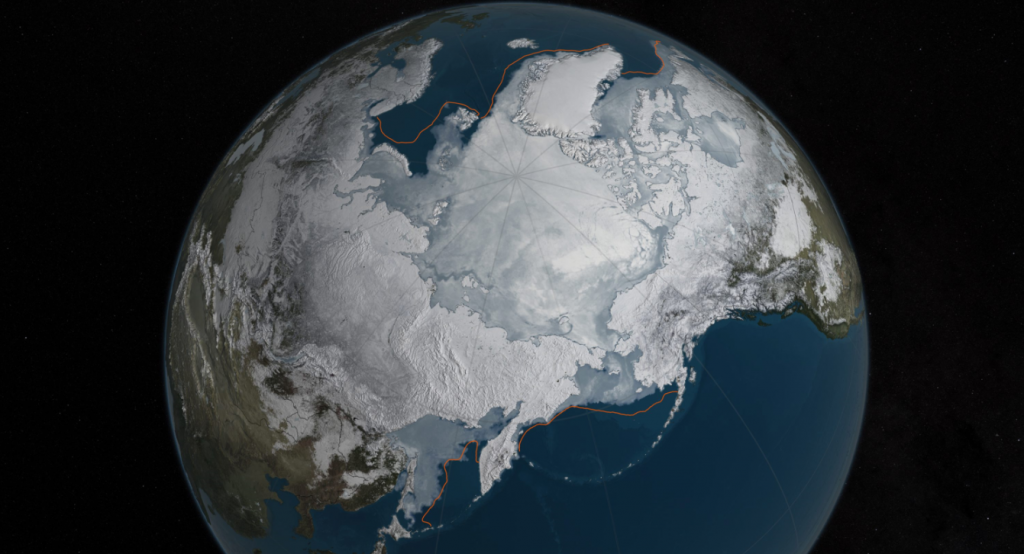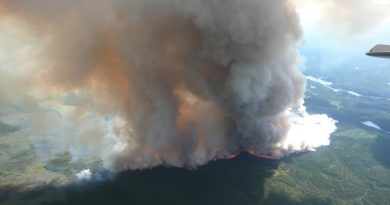Arctic sea ice hits new record winter low

Arctic sea ice contracted to a new record winter low this year with the largest declines in the Barents and Bering seas, while the Canadian Arctic saw more modest sea ice loss, according to new research.
“The heat this winter over the Arctic has been sort of relentless,” said Mark Serreze, director of the U.S.-based National Snow and Ice Data Center. “It’s been very warm all winter, it really hasn’t stopped.”
Listen to the full interview with Mark Serreze:
Serreze says this year’s seasonal maximum extent of sea ice, which is typically reached in mid-March, is the lowest he’s ever seen in his career of studying ice in the Arctic.
“The Arctic sea ice is really in decline,” said Serreze, speaking to RCI from his office in Boulder, Colorado. “It’s losing ice in the winter, it’s losing ice in the summer and we could be looking at a very different Arctic 20 years from now.”
The maximum extent of sea ice before it begins its spring melt was 1.12 million square kilometres below the long term average this winter, Serreze said.
“It’s a lot of real estate that we’re talking about here,” he said.
Typically the biggest losses of sea ice happen at the end of summer, Serreze said.
“But now what we’re seeing is that at the end of winter, at the maximum, we’re really losing a lot of ice kind of at this end of the season,” Serreze said. “So, things are really starting to change quickly.”
Unequal loss of sea ice
The decline of sea ice doesn’t affect all regions equally. It is much more pronounced in the Barents Sea, off the coast of northern Scandinavia and Russia, as well as in the Bering Sea between Russia’s Choukotka region and Alaska.
“It’s a combination of a couple of things,” Serreze said. “Number one, it’s been a very warm Arctic this winter, the warmest I’ve ever seen. And also in that sector, it appears that the transfer of ocean heat into the region has played a big role.”
It seems heat coming from the Atlantic Ocean into the Barents Sea keeps the ice from growing throughout the winter, Serreze said.
By contrast the Canadian Arctic is covered in ice because ocean currents tend to pack up ice against the Canadian Arctic archipelago on a continual basis, Serreze said.
‘Profoundly different Arctic’
Another factor in declining sea ice this year is the effect of the El Nino weather phenomenon in the Pacific, he said.
Temperatures over the Arctic Ocean in December, January and February were 2 C to 6 C above average in nearly every region.
Around the end of December, there was a very unusual pattern of atmospheric circulation that pumped up a lot really warm air way up to the Arctic, driving up temperatures around the North Pole to or just above the freezing point for a brief period, Serreze said.
“That’s pretty much unheard of,” Serreze said. “I’ve been studying Arctic climate for 30 years and I’ve never seen anything like it.”
The world is looking at a scenario where 30 years from now there will be no more Arctic sea ice in the summer, he said.
“That’s going to be a profoundly different Arctic,” Serreze said. “It’s going to have big impacts on things like shipping, extraction of natural resources, because you can get to the oil and natural gas that is there.”
Losing so much sea ice cover could lead to a much warmer Arctic, which in turn will lead to much warmer weather in mid-latitudes, he said.
“You would see shifts in jet stream patterns and shifts in the storms that we associate with these jet stream patterns,” Serreze said.
Related stories from around the North:
Canada: Canadian study looks at Arctic beetles as climate change markers, Radio Canada International
Finland: Warm Easter predicted across Finland… even for Lapland, Yle News
Greenland: Changing Sea Ice: The Ripple Effect (VIDEO), Eye on the Arctic
Norway: 2014 warmest year in history for Norway, Barents Observer
Sweden: Storm Helga weather warning for Sweden, Radio Sweden
United States: Arctic’s ‘startling’ winter warmth ‘milepost’ say scientists, Alaska Dispatch News



